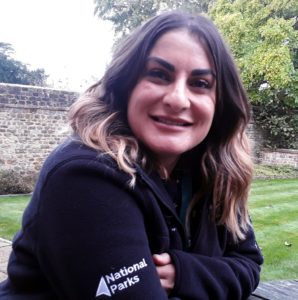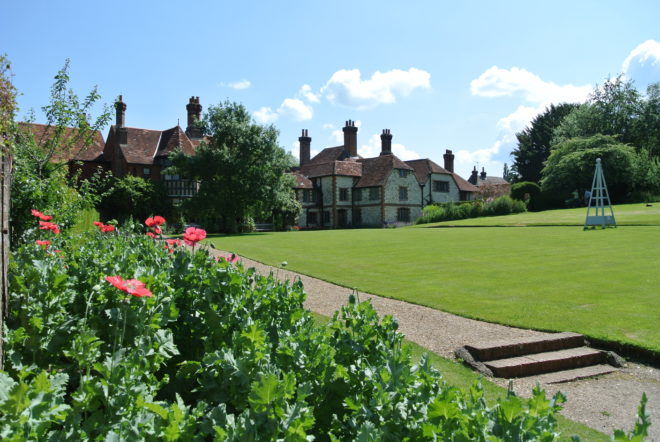A digital delight! Explore the South Downs’ amazing art, history and culture
April 8, 2020
A fascinating collection of digital assets, ranging from the delightful diaries of a founding father of natural history to a virtual tour of an iconic 17th century house, are available for the public to enjoy.
While most creative and cultural venues remain closed, Anooshka Rawden, Cultural Heritage Lead for the National Park, is encouraging people to connect with the heritage of the South Downs and surrounding areas – all from the comfort of their own homes.
 Anooshka explained: “There’s nothing quite like a visit to a museum, stately home or art gallery and having the chance to come face-to-face with a piece of history.
Anooshka explained: “There’s nothing quite like a visit to a museum, stately home or art gallery and having the chance to come face-to-face with a piece of history.
“Yet cultural heritage organisations across the National Park have really invested in their websites and digital assets in recent years, meaning you can step back in time and learn about something really fascinating from home.
“More than that, cultural heritage organisations have explored ways to help ease impact of Covid-19 restrictions by offering great learning resources that you could incorporate into your home schooling plan, as well as activities and online classes to keep you entertained at home. Cultural heritage organisations have been hit hard by Covid-19 and like so many visitor-led organisations, this is going to be a challenging period for the cultural heritage sector. It’s important that we come together to support them and the great work they do. What we have found is that even when facing challenges at this scale, we still as a society crave creativity and connection, and many creative and cultural organisations are seeing significant interest in their online resources.
“With help from our cultural heritage organisations in and around the National Park, we have compiled an informative list, giving a snapshot of the kind of digital resources out there. I hope people have fun exploring and support their local museums, galleries and heritage organisations from their homes.”
Gilbert White & The Oates Collection
The museum is this year celebrating the 300th birthday of Gilbert White by highlighting entries from his diaries highlighting the changing seasons and wildlife. You can follow Gilbert’s diary through @gilbertwhitewt.
In addition, if you are home schooling and looking for creative online resources, Gilbert White and the Oates collection have a range of downloadable resources available including KS1 and KS2 Literacy packs on Antarctic Explorer Lawrence Oates, Frank Oates who explored Africa and Central America and Gilbert White, who did what we can all do a little of at the moment by exploring his garden and local area to better connect with nature and wildlife
http://www.gilbertwhiteshouse.org.uk/downloads/
Also coming soon will be some resources on the collections, talks on Gilbert White, video tours of exhibitions and tips on gardening and baking! You can see the latest digital activities on the museums website (https://www.gilbertwhiteshouse.org.uk/) and on Twitter @GilbertWhites
Gilbert White & The Oates Collection are a charitable trust, who rely on income from visitors to operate. You can find out more here: https://www.gilbertwhiteshouse.org.uk/donations/
Charleston Trust
Charleston is a house, garden and art gallery situated in the South Downs National Park. From 1916, it was the home of artists Vanessa Bell and Duncan Grant, who were key members of the Bloomsbury group.
Today, Charleston runs a year-round programme of exhibitions; as well as workshops, talks, events and a portfolio of festivals which attract over 20,000 visitors annually and have welcomed speakers including Sir David Attenborough, Kamila Shamsie, Ali Smith, Grayson Perry and Jeanette Winterson.
Charleston’s website includes useful background to the role of the house in the history of the Bloomsbury group and includes room-by-room tours that you can enjoy (see: https://www.charleston.org.uk/charleston-room-by-room/). Find out more by visiting their website: https://www.charleston.org.uk/ You can also follow Charleston on Twitter @CharlestonTrust
Charleston is a charity and receives no public funding. Ithas had to cancel the Charleston Festival, which provides much needed financial support for Charleston’s ongoing preservation and work. You can find out more here: https://www.charleston.org.uk/charleston-emergency-appeal/
Weald and Downland Living Museum
The Museum is this year celebrating its 50th birthday and as a living history site, has a website full of interesting content, as well as an active Twitter page, and lots of things you can do from home, including creative writing. They also regularly feature videos of their farm animals, from heavy horses to cows, in action managing their 40 acre site. There are some fantastic videos you can access on YouTube from the museum, showing everything from the use of traditional dye to horse drawn timber wagons in action, all usually with a backdrop of bird song and breeze. See their videos here: https://www.youtube.com/user/wealddownlandmuseum
They currently have a historical fiction short story competition running, which you can find out more about here: https://www.wealddown.co.uk/historical-fiction-short-story-competition-2020/ There will be a special competition for under 18s announced soon.
Follow them on Twitter @WealddownMuseum and access their website here: https://www.wealddown.co.uk/
90% of their income comes from visitors, and so now more than ever the museum needs your support to stay afloat. You can find out more here: https://www.justgiving.com/campaign/SupportWDLM
Pallant House Gallery
Pallant House Gallery explores British art from 1900 through to the works of contemporary artists. Their collection includes works by Barbara Hepworth, Henry Moore, Graham Sutherland, Lucian Freud and Walter Sickert.
You can sign up for a weekly email each Monday, giving you a series of ideas on how to stay creative at home, aimed at all ages. This might include downloadable craft activities, and Instagram art quizzes. The gallery will also be sharing films and new articles to enjoy at home. This includes some regular blogs: https://pallant.org.uk/perspectives/?utm_campaign=535955_Lockdown%20Email%201&utm_medium=email&utm_source=Pallant&dm_i=4UQG,BHJN,32W26T,19HS8,1 and you can follow the Gallery on Twitter for more news on activities from home https://twitter.com/PallantGallery?utm_campaign=535955_Lockdown%20Email%201&utm_medium=email&utm_source=Pallant
Pallant House is a charity, and relies on donations to support its work and care for its collections. You can find out more here: https://pallant.org.uk/support-us/?utm_campaign=535955_Lockdown%20Email%201&utm_medium=email&utm_source=Pallant&dm_i=4UQG,BHJN,32W26T,19HS8,1
Royal Pavilion & Museums Brighton
The origins of the Royal Pavilion and Museums, Brighton, began with the purchase of George IV iconic pavilion by the Corporation of Brighton in 1850. Built up over 150 years, Royal Pavilion and Museums collections comprise nearly 2 million artefacts and includes three designated collections – collections of objects recognised for their national importance – world art, decorative art and natural sciences. In addition they hold archaeology and local history collections, costume and textiles, fine art, toys, musical instruments, coins, film and media. Their collections tell the story of the local area, including the South Downs.
You can learn more about the museum collections through ‘Close Look Collections’ (see: http://closelook.brightonmuseums.org/. This is new daily blog where the museum invites people to look closely at an object in the collections using new web technology, enabling you to zoom in on hi-res images. You can also explore ‘100 Pioneering Women of Sussex’ Blog (see: https://brightonmuseums.org.uk/discover/stories/100-pioneering-women-of-sussex/) Written to accompany the museum’s First Women Portraits exhibition in Brighton Museum, there are some great stories about notable local woman in here. The museum’s website enables you to explore the collections across Brighton Museum, the Royal Pavilion, Preston Manor and the Booth Museum, from Renaissance portraits to beautiful butterflies: https://brightonmuseums.org.uk/
You can also follow Royal Pavilion and Museums on Twitter @BrightonMuseums, and YouTube: https://www.youtube.com/user/BrightonMuseums
The Novium Museum
The museum tells the story of Chichester District, which includes the art, archaeology and social history of the South Downs, and holds over 500,000 artefacts. Its collections explore everything from Roman villas to meat paste manufacture, cattle markets and William Blake.
The museum is working on making more of its collections and exhibitions available online for enjoyment at home, including virtual tours which will be regularly uploaded onto their website throughout April (see: www.thenovium.org/virtualmuseum). Alongside virtual tours, they will be providing oral history videos and learning activities, as well as live curator Q&As, craft activities for all ages to do at home and design challenges.
The museum is also working to increase the online content of our current headline exhibition, Mystery Warrior: The North Bersted Man (see: www.thenovium.org/mysterywarrior). This nationally important discovery of an Iron Age warrior burial can be explored online, alongside some planned online exhibitions which will also launch over the coming weeks, including Medieval Jewellery, Shippams and the anniversary of VE day.
You can also follow the Novium on Twitter @TheNovium, on Instagram (see: https://www.instagram.com/noviummuseum/) and YouTube: https://www.youtube.com/user/TheNovium.
Hampshire Cultural Trust
Hampshire Cultural Trust manages and supports 23 attractions across the county, including museums, galleries and arts centres. Their museum collections comprised 2.5 million objects telling the story of Hampshire, which includes significant holdings on the history of the South Downs, and its role as an inspiring landscape. The Trust has launched a new online platform ‘Culture On Call’ (see: https://www.cultureoncall.com/). The website is full of things to read, videos to watch and activities to do from home, including online classes, learning and workshops, news, and articles on history and heritage.
As an independent charity, the Trust relies on income from visitors to keep caring for its collections, and providing culturally enriching activities for communities across Hampshire. You can find out more here: https://www.cultureoncall.com/support/

